
10 interesting facts you need to know about kabaddi
The contact sport of kabaddi has been one of the most popular indigenous games played in India since its origin. It is often called the 'game of the masses’ because of its tremendous public appeal and delightful simplicity.
Also read: Kabaddi: Rules and it’s different formats
The Star Sports Pro Kabaddi has been instrumental in bringing this sport back to the masses through its slick, enjoyable format. Now in its third season, the league has captured the imagination of fans in the country and has firmly established itself as one of the best conducted sports tournaments in India.
With the sport being celebrated globally, this is an ideal time to have a look at some of the sport’s lesser-known facts. Here are 10 interesting things you may not know about kabaddi:
1. The official game of more than one Indian state
Although there is no consensus on the origin of the word ‘kabaddi’, many believe it has come from the Tamil word ‘kai-pidi’, which literally means to hold hands. In India, the sport traces its roots to the state of Tamil Nadu, where it has now been declared the state game. Other Indian states which have named kabaddi as their state sport are Andhra Pradesh, Telangana and Punjab.
2. The Mahabharata refers to kabaddi too!
The origins of kabaddi can be traced back to around 4,000 years ago in ancient India, if one is to believe historians. The game has been mentioned in many mythological epics, the most significant of which is its reference in the Mahabharata during Abhimanyu’s battle with the Kauravas. Buddhist literature also reveals that Lord Gautama Buddha also played this sport, often for recreation.
3. The sport of many names
Kabaddi is known by different names in different parts of India. In southern India it is called Chedugudu, while in some parts of the North it is referred to as Kaunbada. In the East, the sport has been christened Ha-Do-Do while in the Western part of the country, it is called Hu-Tu-Tu.
The sport has a massive importance in India's neighbouring countries like Bangladesh and Nepal too; it has even got the status of Bangladesh's national sport. Today, the sport is played in many nations such as Maldives, Spain, Argentina, Italy, Belgium, Denmark and the USA, among others.
4. Kabaddi at the Olympics
India was responsible for presenting this wonderful contact sport before the world at the 1936 Berlin Olympics. The Hanuman Vyayam Prasarak Mandal of Amravati, Maharashtra demonstrated the sport expertly at the Games, which was kabaddi's first international exposure. Just two years later, kabaddi was introduced at the Indian National Games in Calcutta.
Subsequently in 1950, the All India Kabaddi Federation came into existence which helped to organize the Senior National Championship from 1952. The Amateur Kabaddi Federation of India (AKFI) was formed in 1972 and that introduced national competitions at the junior level too.
5. Two formats, one perfect co-existence
There are two main formats of kabaddi – the 'International Rules Kabaddi' and the 'Circle-style Kabaddi'. Despite the essence of the sport remaining the same in both, the rules vary in the two formats.
For International Rules kabaddi a rectangular court of 13×10 metres is required, while Circle-style kabaddi is played on a circular pitch that has a radius of 11 metres. Both these styles have their separate World Cups.
The three styles that were prevalent in India over the ages were Amar, Sanjeevani and Gaminee. Modern day kabaddi is a synthesis of all these styles with a few modifications in rules and regulations.
